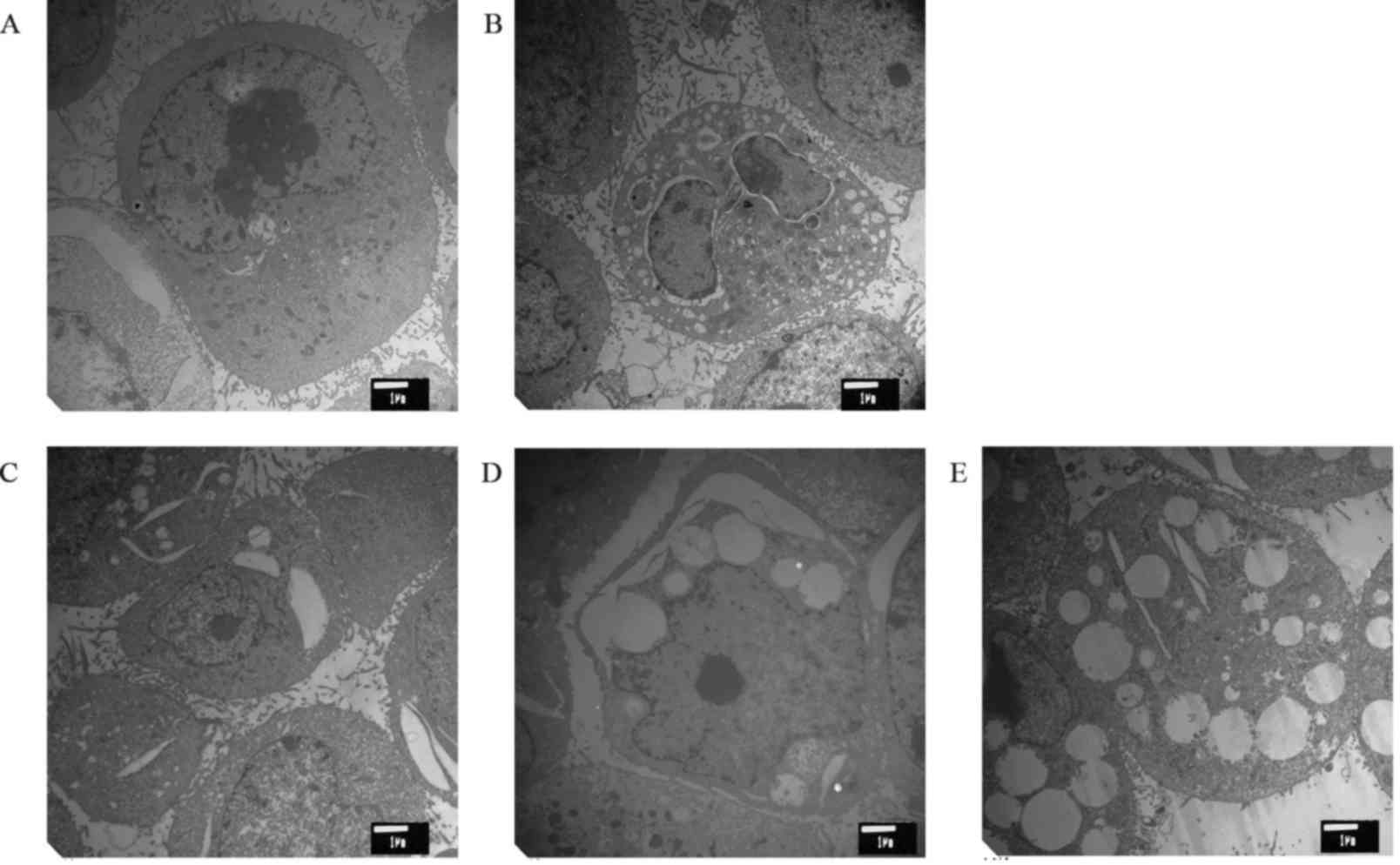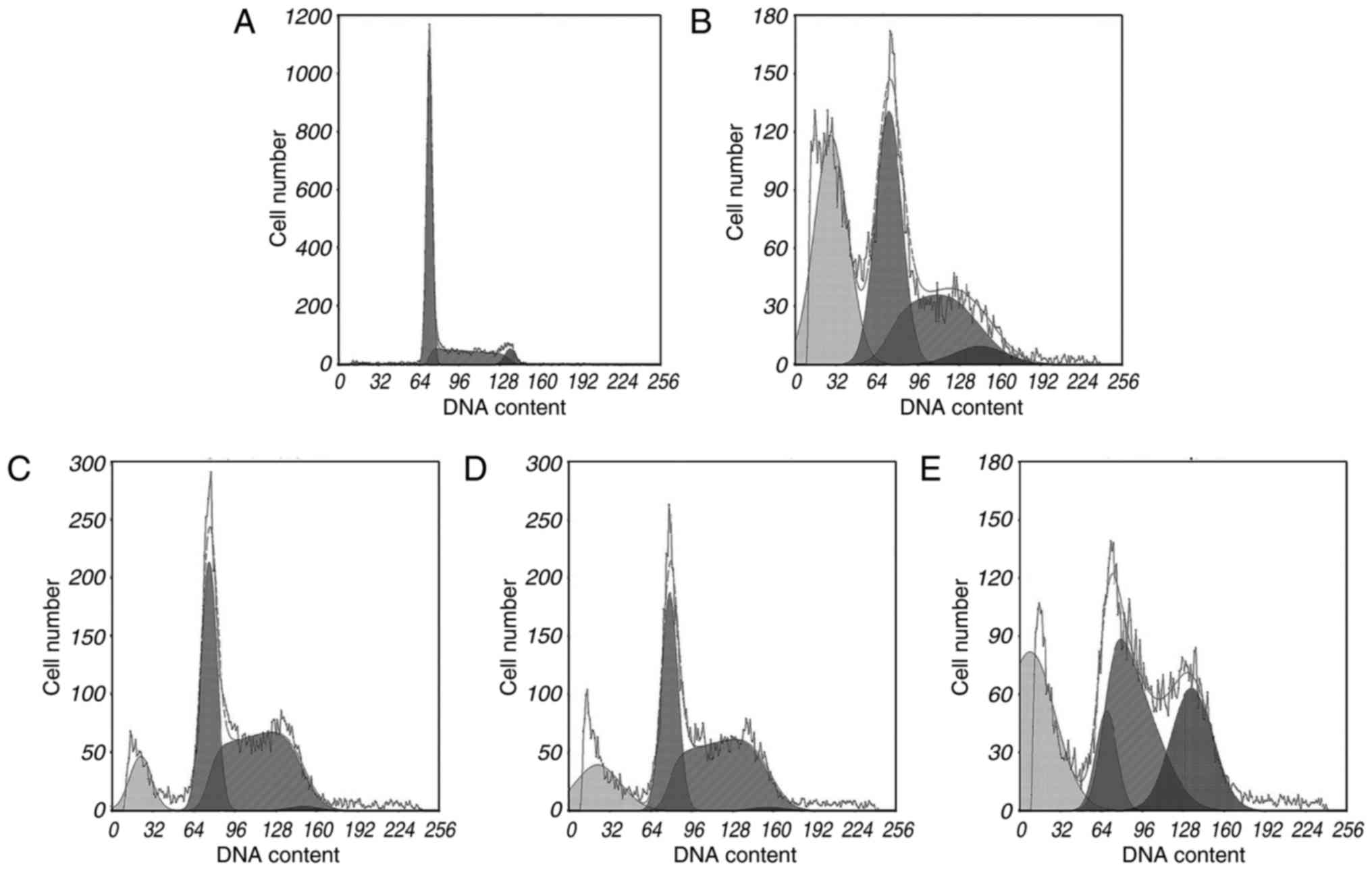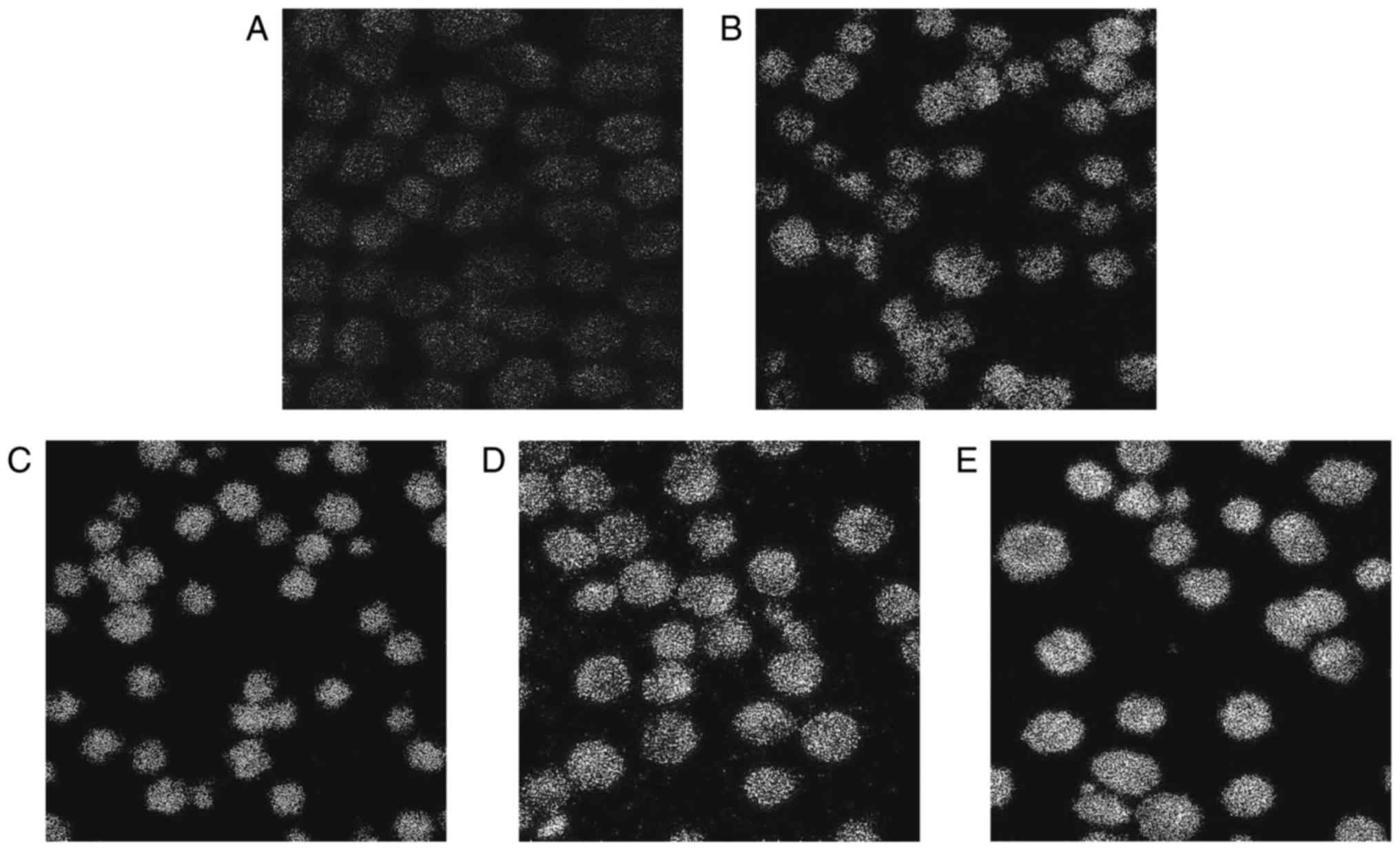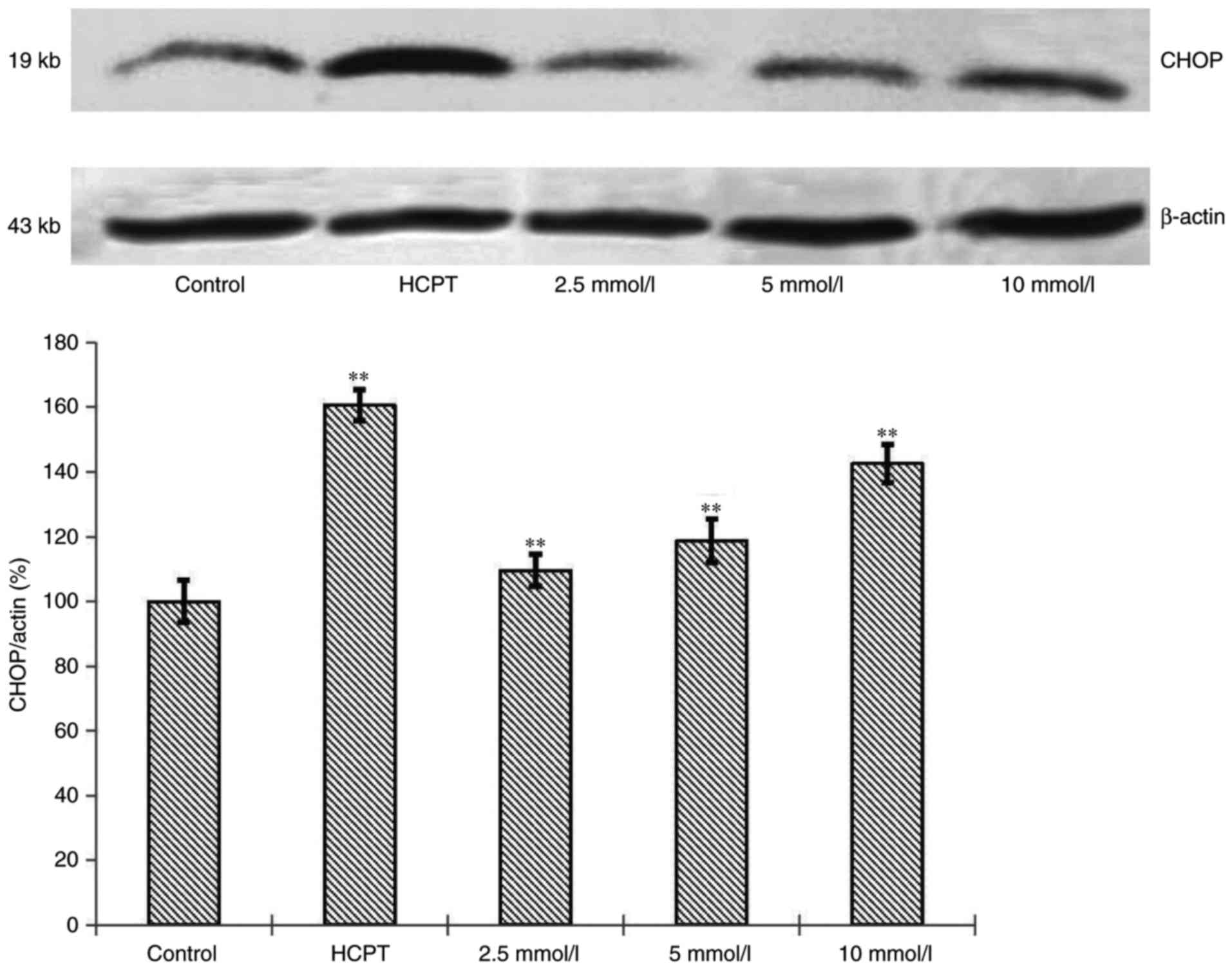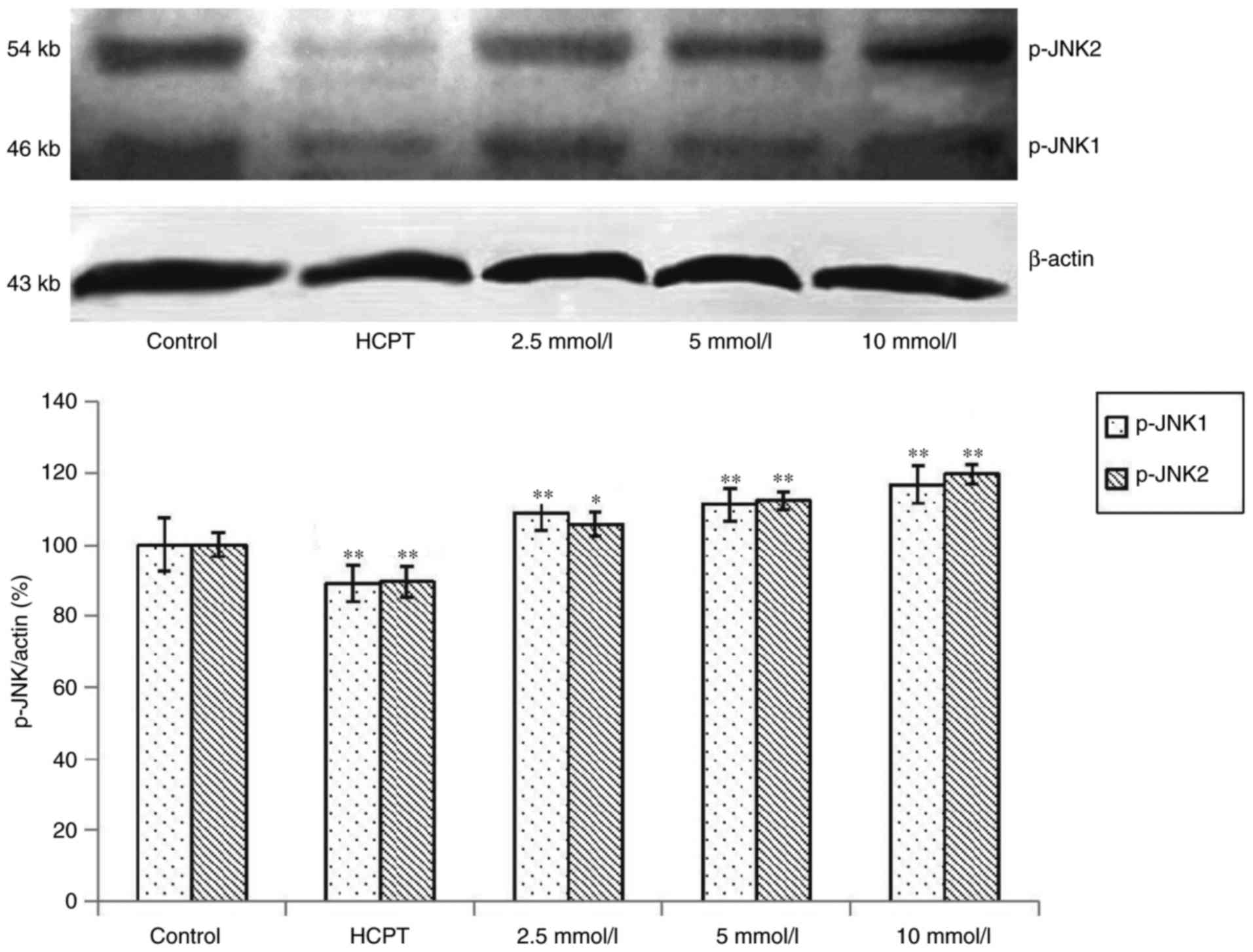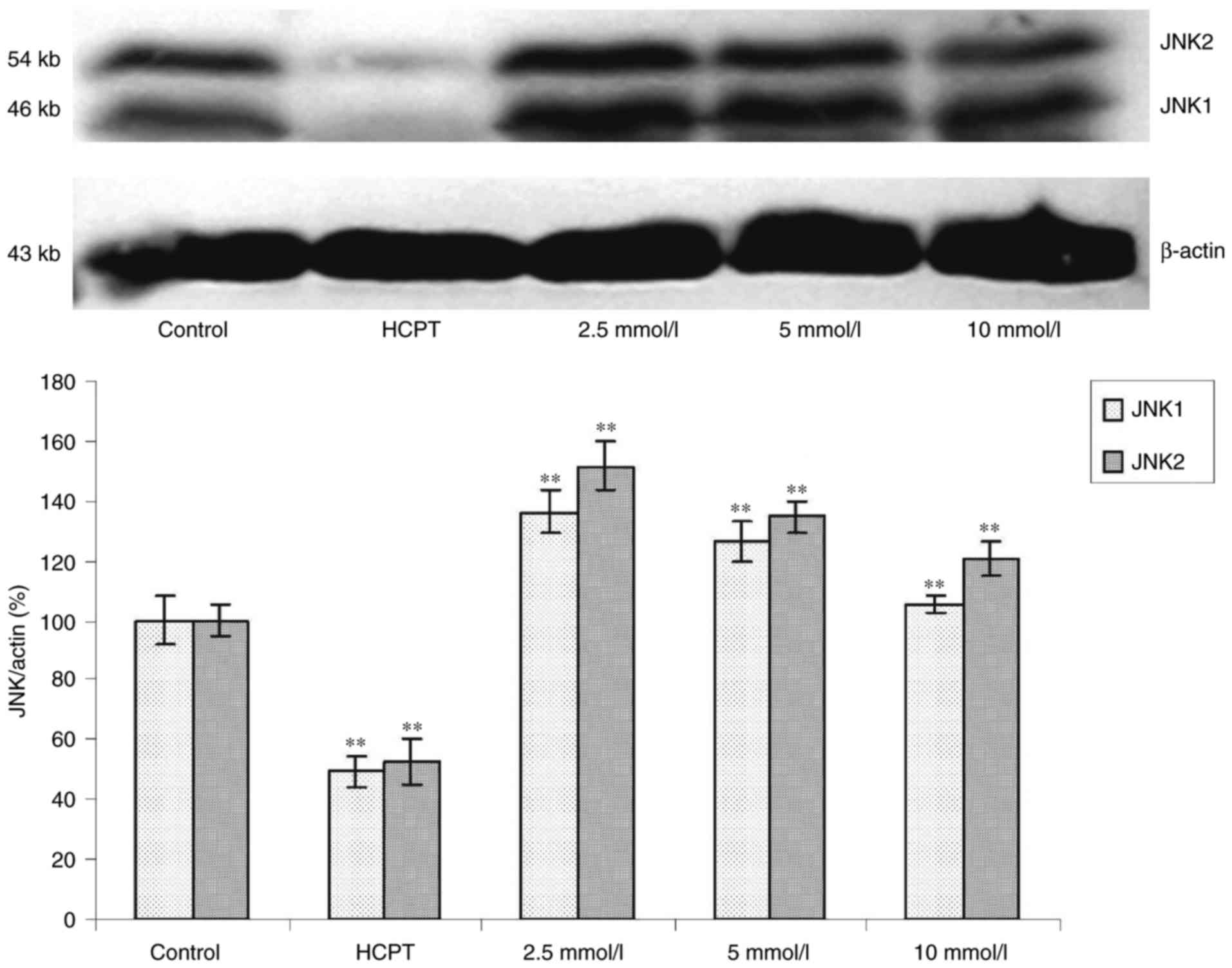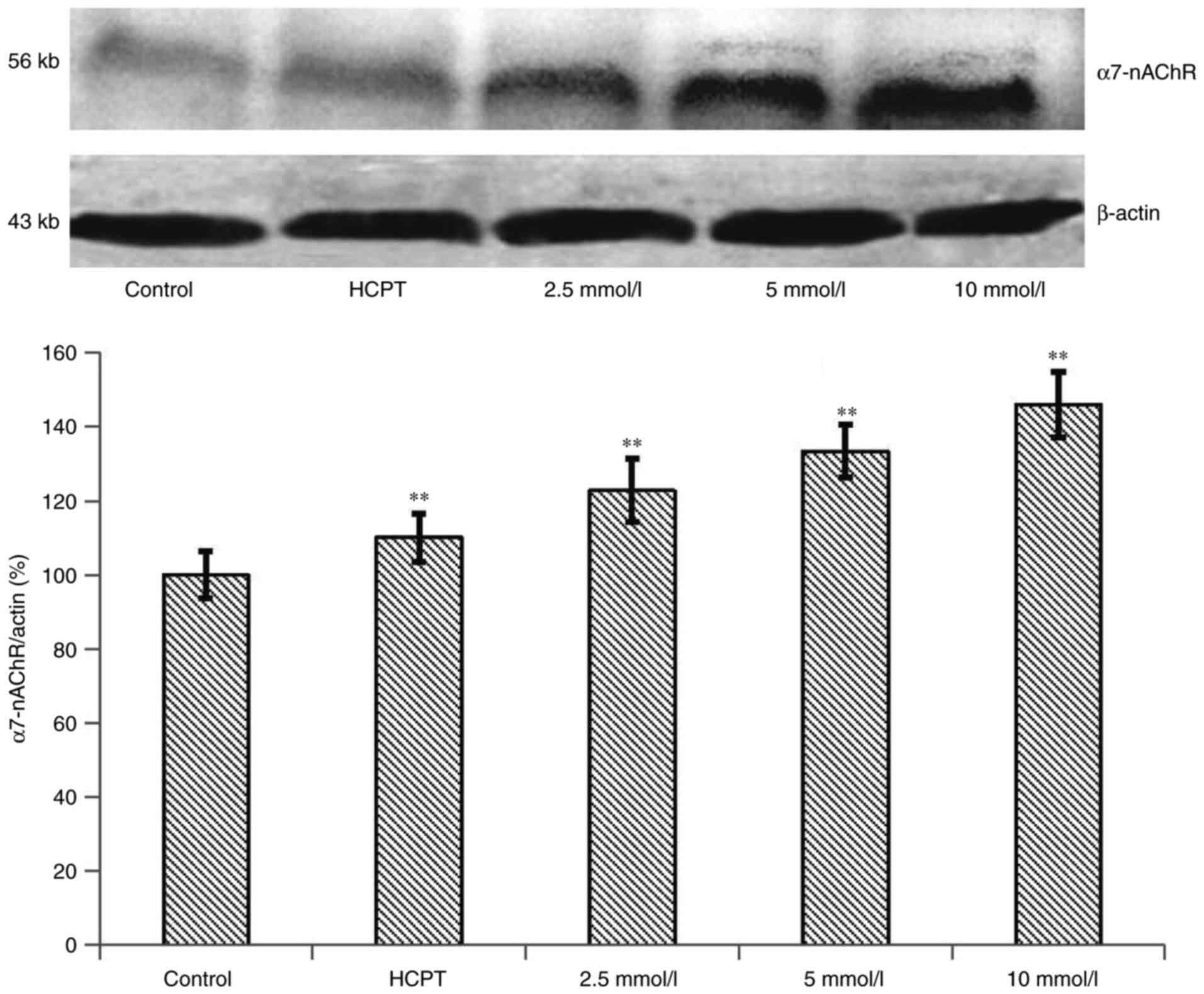Cytisine induces endoplasmic reticulum stress caused by calcium overload in HepG2 cells
- Authors:
- Published online on: January 8, 2018 https://doi.org/10.3892/or.2018.6200
- Pages: 1475-1484
Abstract
Introduction
Quinolizidine alkaloids have previously been demonstrated to exhibit antitumour activities in vitro and in vivo (1,2). Cytisine, a quinolizidine alkaloid from Sophora Alopecuraides L., has been widely used for the treatment of central nervous system diseases. It has previously been demonstrated that cytisine may significantly inhibit neuronal apoptosis induced by NMDA exposure by reversing intracellular Ca2+ overload and balancing the expression levels of Bcl-2 and Bax (3). Furthermore, several in vitro studies have also confirmed the antitumour activities of cytisine. Cytisine was found to inhibit human cancer cell lines, including HepG2, A549, K562, Ec109, HL-60 and U937 cells (4). Our team confirmed the molecular mechanisms underlying cytisine-induced apoptosis of HepG2 via a mitochondrial pathway; however, the specific mechanism underlying endoplasmic reticulum (ER) stress remains to be elucidated.
Apoptosis is a crucial mechanism for cell clearance. It is now accepted that cell apoptosis has mainly three apoptotic signalling pathways, including the mitochondrial, the death receptor- and the ER-associated pathway (5–7). In recent years, researchers have discovered that ER stress-mediated apoptosis is a new signalling pathway for apoptosis (8). The endoplasmic reticulum (ER), a membrane-bound organelle, plays an essential role in eukaryotic cell processes, including synthesizing, sorting, assembling, modifying and trafficking proteins, and maintaining intracellular Ca2+ homeostasis (9). The normal functioning of the ER signalling cascades requires high concentrations of free calcium ions within the ER lumen. Impairment of Ca2+ homeostasis or other noxious stimuli may trigger an ER stress response that is manifested by either an unfolded protein response (UPR) or an ER overload response (EOR) within the ER lumen (10–13). However, if the stress persists on the ER for a longer period of time, the ER stress triggers cell death (typically apoptosis) mainly through three pathways, including CHOP (14), JNK (15) and caspase-12 (16–18). Although caspase-12 has been implicated in ER stress-induced apoptosis in rodents, it is controversial whether similar mechanisms operate in humans. Recent research has indicated that caspase-4, which is one of the closest paralogs of rodent caspase-12, plays an important role in cell death (19). Thus, the present study investigated the ER stress effects of cytisine on HepG2 cells in relation to CHOP, JNK and caspase-4.
Additional studies have indicated that cytisine can be used as an nAChR partial agonist in clinical use as a smoking cessation aid. Therefore, cytisine is considered to be superior to nicotine-replacement therapy for smoking cessation (20–22). Nicotinic acetylcholine receptors (nAChRs) consist of various types of subunits, such as α2-α10, β2-β4, which are a complex of five subunits forming hetero- or homo-pentamers that form a central ion channel. nAChRs were originally identified to be only expressed in the nervous system and at neuromuscular junctions (muscle type nAChRs). However, the discovery of widespread expression of nAChRs in the cell membrane of all mammalian cells, including cancer cells, suggested its direct role in the development and progression of cancers (23). Therefore, nAChRs are viewed as a novel drug target for the prevention and treatment of various forms of cancers. Recently, increasing evidence has shown that α-7 nicotinic receptors exhibit the highest permeability for Ca2+, promoting cell death via a release of Ca2+ from intracellular stores and intracellular Ca2+ overloading (24,25).
The major aim of the present study was to elucidate the the effects of cytisine on ER stress in HepG2 cells in terms of the intracellular calcium concentration and the three pathways involved in ER stress, including CHOP, JNK and caspase-4. Additionally, the present study investigated the effect of cytisine on the expression of nAchR.
Materials and methods
Instruments and reagents
Cytisine (no. 20111101C; Shanxi River Pharmaceutical Co., Ltd., Xi'an, China); human hepatocellular carcinoma cell line, HepG2 (Life Sciences and Environmental Sciences Development Centre of Harbin University of Commerce, Harbin, China); RPMI-1640 medium (no. 20130507; Gibco Co., Carlsbad, CA, USA); fetal calf serum (FCS) (no. 20140206; Zhejiang Tianhang Biotechnology Co., Ltd., Zhejiang, China); propidium iodide (PI) (no. P4170; Sigma Co., St. Louis, MO, USA); fluorescence microscope (Olympus Corporation, Tokyo, Japan); HCPT (no. H109197; Aladdin Reagent Co. Ltd., Shanghai, China); monoclonal antibody of β-actin (no. 141125), p-JNK (no. A1514) (both from ZSGB-BIO Co., Ltd., Beijing, China); monoclonal antibody of GADD153 (no. 980787W; Beijing Biosynthesis Biotechnology Co., Ltd., Beijing, China), JNK (no. 150116; Wanleibo Co., Ltd., Shanghai, China); caspase-4 test kit (no. 20140526; Beyotime Institute of Biotechnology, Haimen, China); JEM-1220 transmission electron microscope (JEOL Ltd.); EPICS XL-MCL flow cytometry (Beckman Coulter, Inc., Brea, CA, USA); 680 enzyme-linked analyser (Bio-Rad Laboratories, Inc., Hercules, CA, USA); peroxidase-conjugated AffiniPure goat anti-rabbit IgG (H+L; cat. no. ZB-2301) and peroxidase-conjugated AffiniPure goat anti-mouse IgG (H+L; cat. no. ZB-2305) (both from ZSGB-BIO Co., Ltd.).
Effect of cytisine on the morphological appearance of HepG2 cells
Transmission electron microscopy was used to observe the morphological appearance of the HepG2 cells after drug treatment (26). Cells were gently harvested after trypsin digestion and washed twice with PBS. Approximately 3×105 cells were treated in single wells of 6-well plates. The cultured HepG2 cells were exposed to cytisine at concentrations of 2.5, 5 and 10 mM, or they were exposed to HCPT at concentrations of 60 µM for 24 h at 37°C with 5% CO2. Since cytisine and HCPT both belong to the same family of alkaloids, HCPT was used as the positive drug in the present study to verify that the experimental method was correct. A blank control group was added with the same volume of RPMI-1640 culture medium, and the cells were collected after 24 h. Next, 2% glutaraldehyde was used to fix the cells for >2 h, and they were immobilized with osmium acid. After alcohol gradient dehydration, all groups were treated with epoxy resin embedding, ultrathin sectioning, uranyl acetate and lead citric acid double staining and then imaged under the transmission electron microscope.
Apoptosis assays
Quantitative analysis of the apoptosis was evaluated via flow cytometry with PI staining according to prior guidelines (27). Cells were gently harvested after trypsin digestion and washed twice with PBS. The cells were then centrifuged at 1,000 rpm for 10 min. Cells (1×106) were treated approximately into a single cell suspension with PBS solution and fixed with 70% ice-cold ethanol at 4°C overnight. Afterwards, the cells were washed twice with PBS and stained with a solution containing 800 µl of PI (PI staining contains sodium citrate 33.4 mg, PI 5 mg, RNase A 1 mg, joined Triton X-100 0.5 ml) for 30 min in the dark at room temperature. A minimum of 10,000 cells were maintained for all of the samples. The cells were later analysed for their DNA content using flow cytometry. By analysing the DNA histograms, the percentage of the cells in different cell cycle phases was evaluated using MyltiCycle for Windows 32-bit software (Beckman Coulter, Inc.). Finally, the cells with sub-G0/G1 DNA (sub-G1) were calculated as apoptotic cells. Apoptosis was recorded using the laser line of 488/630 nm.
Confocal laser scanning microscope (CLSM) analysis
The accumulation of Ca2+ ions in the cytoplasm was studied using the fluorescent dye, Fluo3 AM (28). Approximately, 3×105 cells were seeded per well in 6-well plates and incubated for 24 h before treatment with various concentrations of cytisine and a further 24 h of incubation at 37°C with 5% CO2. Cytisine at concentrations of 2.5, 5 and 10 mM or HCPT at a concentration of 60 µM was added, and the plate was incubated at 37°C in 5% CO2. The HepG2 cells were resuspended with PBS at 1,500 rpm for 10 min after trypsin digestion. After fixation, the cells were incubated with 200 µl of Fluo3 AM (4 µg/ml) to detect the intracellular Ca2+ at 37°C at ~30 min. Next, the cells were washed twice with PBS. The fluorescence emitted by the Fluo3 AM when bound to Ca2+ ions was recorded using the laser line of 488/570 nm.
Western blot analysis
Cells were harvested after the treatment with test drugs for 24 h. After the indicated treatments, the HepG2 cells were harvested and lysed with a cell lysis solution at 4°C for 30 min. Whole cellular proteins were extracted and cytosolic fractions were prepared following the procedure described by the manufacturer. Total proteins were quantitatively assayed using the BCA method. A loading buffer was added to the cytosolic extracts, and it was boiled for 10 min. Afterwards, 50 µg of protein was loaded onto a 15% sodium dodecyl sulphate-polyacrylamide gel electrophoresis (SDS-PAGE) gel and run at 80 V for 30 min and 120 V for 1 h. Proteins were transferred onto nitrocellulose membranes. Afterwards, incubation was performed for 1 h in a blocking solution (5% non-fat dry milk in 20 mM of TBS with 0.1% Tween) at room temperature. Next, the membranes were gently washed with diluted TBS-T and subsequently incubated for 24 h with the primary antibody of GADD153 (1:500), JNK (1:500), p-JNK (1:500) and α7-nAChR (1:500) at 4°C, respectively. The secondary antibody was added at 1:2,000 dilutions and incubated at room temperature for 2 h. Cell membranes were removed and coloured with DAB agent (29,30). Membranes were examined via chemiluminescence detection using a photographic film. The image was captured using a Tannon gel imaging system, and the hybrid band was quantitatively analysed with Gel-Pro Analyzer 3.1 density analysis software.
Caspase activity assay
The enzymatic activity of caspase-4 was determined using a caspase colourimetric assay kit according to the manufacturer's protocol. Briefly, the cells were lysed in a lysis buffer for 15 min in an ice bath. The lysed cells were centrifuged at 20,000 × g for 10 min, and 50 µl of the protein was incubated with 40 µl of a reaction buffer and 10 µl of the colourimetric tetrapeptides, Ac-DEVD-pNA for caspase-4 at 37°C for 1 h. The optical density of the reaction mixture was quantified spectrophotometrically at a wavelength of 405 nm. The caspase enzymatic activity in the cell lysate is directly proportional to the colour reaction.
Statistical analysis
Differences in proliferation between different cell lines were analysed using one-way ANOVA. Statistical analysis was performed using SPSS 19.0 software. (SPSS, Inc., Chicago, IL, USA). P<0.01 was considered to be a statistically significant difference.
Results
Effect of cytisine on the morphological appearance of HepG2 cells
The effect of cytisine on the ultra-structure of the HepG2 cells is shown in Fig. 1. Cells from the control group had the following characteristics: a clear structure, complete cell structure, a small number of microvilli on the cell surface, large nuclei, abundant euchromatin and obvious nucleolus. In addition, we also observed many free ribosomes, and the rough ER and mitochondria were scattered in the cytoplasm. In the positive control group, the mitochondria were reduced, and the cell processes were obviously decreased. The ER swelled and expanded, and typical apoptotic bodies appeared. The cell surface microvilli decreased or disappeared after different concentrations of cytisine. Under electron microscopy, the apoptosis of the cells with cytoplasmic vacuolization was found to be significant. Retraction of the cytoplasm, chromatin condensation, expansion of the perinuclear space, rupture of the membrane, expansion of the ER, and swelling of the mitochondria were observed in HepG2 cells after drug treatment.
Apoptosis analysis
During apoptosis, activation of certain nucleases results in DNA degradation. The sub-G1 method relies on the fact that after DNA fragmentation, there are small fragments of DNA capable of being eluted following washing in either PBS or a specific phosphate-citrate buffer. This finding means that after staining with a quantitative DNA-binding dye, cells that have lost DNA may take up less stain and may appear to the left of the G1 peak. Rates of apoptosis were analysed using PI staining and flow cytometric analysis. The FCM results indicated that cytisine was capable of inducing apoptosis at concentrations of 2.5, 5 and 10 mM (Table I). In particular, HCPT induced a higher percentage (37.79±1.55%) of apoptosis at 60 mM compared to the control group (P<0.01). As shown in Fig. 2, treatment with cytisine increased the percentage of cells in the sub-G1 phase (P<0.01). The preincubation of HepG2 cells with cytisine (2.5, 5 and 10 mM) significantly increased the sub-G1 cell population (P<0.01). The data demonstrated (Table I and Fig. 2) that cytisine increased HepG2 cell apoptosis rates in a dose-dependent manner.
Table I.Apoptosis rate of HepG2 cells following treatment with cytisine as detected by flow cytometry (mean ± SD, n=3). |
Laser confocal fluorescence microscopy analysis
To determine the contribution of Ca2+ released from intracellular stores to the cytisine-increased [Ca2+]i content, the HepG2 cells were treated with cytisine for 24 h. Our results clearly indicated that cytisine caused an increase in the cytoplasmic Ca2+ levels in a dose-dependent manner (Table II). Cytisine (10 mM) significantly increased the cytisine-increased [Ca2+]i content by 30.69±0.80, and cytisine (2.5 mM) slightly increased the cytisine-increased [Ca2+]i content by 17.98±0.56 (P<0.01). The green fluorescence intensity increased with the increase in drug concentration, as shown in Fig. 3.
Effects of cytisine on the expression of CHOP protein
To confirm our observation that cytisine induced ER stress, we performed immunoblotting analyses on ER-regulated protein, CHOP. CHOP level in the HepG2 cells in the cytisine group was increased compared with the normal group. Significant differences were noted (P<0.01, Fig. 4).
Effects of cytisine on the expression of JNK protein
Western blot analysis revealed that exposure of the HepG2 cells to cytisine for 24 h induced a slight upregulation of expression of the p-JNK1 and p-JNK2 proteins (P<0.01, Fig. 5). In contrast, the expression levels of JNK1 and JNK2 were significantly increased in the HepG2 cells in a dose-dependent manner (P<0.01, Fig. 6).
Effect of cytisine on the activation of caspase-4
As shown in Table III, after treatment of the HepG2 cells with cytisine for 24 h, the activities of caspase-4 were significantly increased compared with the control group (P<0.01). Cytisine led to a significant increase in the level of caspase-4 and significant upregulation of caspase-4 expression.
Effects of the expression of α7-nAChR protein in HepG2 cells
To examine the α7-nAChR expression induced by the overloading of Ca2+, western blot experiments were conducted. As shown in Fig. 7, the α7-nAChR expression level was significantly increased by treatment with 10 mM of cytisine for 24 h compared with the control group (P<0.01). Western blot analysis revealed that the exposure of the HepG2 cells to HCPT for 24 h induced a slight upregulation of the expression of the α7-nAChR protein compared with the control group. The expression levels of α7-nAChR were significantly upregulated in the HepG2 cells in a dose-dependent manner (P<0.01).
Discussion
Apoptosis induction is one of the mechanisms proposed for the anticancer therapeutic effects of cytisine. Our team previously confirmed that cytisine could induce apoptosis in HepG2 cells via a mitochondrial pathway (31). However, the molecular mechanisms of the effects of ER stress due to cytisine have not been thoroughly elucidated to date. ER stress, a newly defined signalling pathway, initiates apoptosis (32–34). In the present study, we demonstrated that Ca2+ overload induced by cytisine promoted endoplasmic reticulum (ER) stress, consequently leading to HepG2 cell apoptosis. In a previous study, we showed that cytisine, which is a naturally occurring quinolizidine alkaloid, had an anticancer effect. Our prior MTT assay investigation proved that cytisine could inhibit the proliferation of human HepG2 cells in a dose-dependent manner (31).
In the present study, morphological changes of apoptotic cells were observed after treatment with different concentrations of cytisine. Cell surface microvilli decreased and disappeared with an increase in drug concentration. Different amounts of spherical protrusions, apoptotic bodies, cell membrane rupture and cytoplasm overflow were observed in the apoptotic cells with transmission electron microscopy. ER dilatation and mitochondrial swelling were observed in the HepG2 cells after a high dose of cytisine. In the positive control group, the mitochondria were reduced, and the cell processes were obviously decreased. Typical apoptotic cells and apoptotic bodies were observed in the HepG2 cells. These results suggested that cytisine induces the apoptosis of the HepG2 cells (Fig. 1).
The ER is associated with protein synthesis, post-translational modification, and absorption and release of calcium ions. However, when the quality control system is overloaded under various stresses, including disruption of Ca2+ homeostasis, ER functions are impaired, and unfolded proteins are accumulated in the ER lumen. This situation is called ER stress. The ER is the primary site of intracellular Ca2+ storage (35–37). Calcium homeostasis is central to all cellular functions and has been studied for decades (38–40). Ca2+ is a critical second messenger that mediates many physiological cellular signalling pathways (41). The ER controls the calcium ion through the ryanodine receptor, inositol triphosphate receptor and sarco/endoplasmic reticulum Ca2+-ATPase (41). Moreover, research has clearly confirmed that [Ca2+]i accumulation contributes to cell death (42). Studies have shown that cytisine can give rise to Ca2+ overload (43). Whether Ca2+ overload induced by cytisine activates apoptosis in HepG2 cells remained undetermined. We hypothesized that cytisine stimulation would cause ER stress due to Ca2+ overload, leading to apoptosis. To determine whether the effects of cytisine on ER resulted in apoptosis, HepG2 cells were treated for 24 h with various concentrations of cytisine. Flow cytometry with PI staining revealed that the drug treatment increased the proportion of apoptotic cells (Table I and Fig. 2), confirming the cytisine-induced apoptosis in HepG2 cells. Next, laser confocal fluorescence microscopy was used to examine the intracellular Ca2+ concentration. Our data showed that cytisine increased the intracellular Ca2+ concentration in a cytisine-dependent manner (Table II and Fig. 3). These results suggested that cytisine increased the intracellular Ca2+ concentration by releasing Ca2+ from the ER, thereby causing ER stress. These findings revealed that calcium as a starting factor could induce ER stress, resulting in HepG2 cell apoptosis. It was concluded that HepG2 cellular exposure to cytisine resulted in a direct and immediate consequence of Ca2+ overload that led to disturbance in Ca2+ homeostasis in the ER, which caused ER stress leading to apoptosis.
When ER stress is prolonged, pro-apoptotic signaling pathways are activated, such as the CCAAT/enhancer-binding protein (C/EBP) and homologous protein (CHOP/GADD153), caspase-12 and JNK-dependent pathways (44,45). The caspase family plays an important role in apoptosis. Previous research has shown that caspase-12 is involved in ER-mediated apoptosis (46). Overexpression of caspase-12 only occurs during ER stress. It has been reported that caspase-12 triggers cellular apoptosis through the caspase-9/caspase-3 pathway. Cleaved caspase-12 reportedly activates caspase-9, followed by activation of caspase-3 (47,48). In a previous study, we found that human caspase-4, one of the closest paralogs of rodent caspase-12, plays an important role in cell death via ER stress. However, the relevance of caspase-12 to ER-induced apoptosis has been questioned due to the absence of caspase-12 in most humans (49). Upregulation of caspase-4 in HepG2 cells had been demonstrated in the present study. When cells were incubated with cytisine, the expression of caspase-4 was significantly higher than that noted in the control (Table III). Thus, we concludes that caspase-4 plays an important role in cytisine-induced apoptosis that is associated with ER stress. It is suggested that Ca2+ overload, as an apoptosis-inducing factor, may cause ER stress to increase caspase-4 expression, which ultimately activates caspase-3 (this result has been confirmed by our team) (31), leading to apoptosis.
Another mediator of programmed cell death in ER-stressed cells is the transcription factor, CHOP. In line with previous reports, we found that significant overexpression of CHOP/GADD153 promotes cell death or DNA damage (50). Elevated levels of CHOP can promote the transcription of Bim, BAX and DR5 while suppressing the induction of Bcl-2 in ER stress (51). In addition, upregulation of the expression of CHOP is involved in caspase activation and mitochondrial events (50). In the present study, the expression of CHOP (Fig. 4) was continuously increased after cytisine treatment in the HepG2 cells. In the present study, calcium overload was hypothesized to result in a high expression of the CHOP gene, which promoted the accumulation of Bim, BAX and DR5 while suppressing the induction of Bcl-2. Indeed, upregulation of the expression of CHOP is involved in ER stress-induced apoptosis, and although it is normally undetectable in proliferating cells, it becomes highly synthesized in cells exposed to cytisine that perturb the homeostasis of the ER, which is linked to the development of apoptosis.
JNK, a member of the Ser/Thr protein kinase family, is induced by stress conditions, such as ER stress (52). Additionally, JNK participates in cell proliferation, survival, and apoptosis (53). It has been confirmed by previous research that inhibition of JNK phosphorylation results in decreased levels of ER stress-induced caspase-3/-7 (54). JNK, which has three isoforms, i.e., JNK1, JNK2 and JNK3, is also one of the signaling pathways of ER. JNK1 and JNK2 are associated with cell death and play an important role in apoptosis (55). To investigate the role of JNK in ER stress that is induced by cytisine, western blotting was used to examine expression levels of JNK1/2 and p-JNK1/2. We found that the expression levels of p-JNK1 and p-JNK2 were significantly enhanced in HepG2 cells in a dose-dependent manner (Fig. 5). JNK1/2 was increased by cytisine treatment (Fig. 6). These results suggested that c-Jun phosphorylation by Ca2+ overload in the HepG2 cells was mainly associated with JNK1/2. Our data suggested that the ER stress-JNK pathway is involved in Ca2+ overload and that cytisine induced ER stress via Ca2+ overload, thereby promoting cell death due to subsequent JNK activation.
nAChRs play an important role in synaptic transmission; thus, the primary focus of nicotine and its receptors has been its physiological effects within the nervous system. However, there is growing evidence suggesting that nAChRs are not only expressed in the nervous system but also in nonneuronal cells, including cancer cells (23,56). In support of our findings, gastric, bladder, colon and non-small lung cancer cells have been shown to express nAChR subunits, and nicotine has been shown to be mitogenic for vascular smooth muscle cells (57). nAChRs are known to play several important roles in cancer cells, such as proliferation, inflammation, angiogenesis and invasion (58,59). Thus, the expression of nAChRs in non-neuronal cells indicates that they possess functions independent of neurotransmission. Therefore, nAChRs are viewed as a novel drug target for the treatment of cancer. Current research indicates that the α-7 nicotinic receptor, which is one of the various types of subunits, is related to intracellular Ca2+ overload (60). However, the actual role of the α-7 nicotinic receptor in HepG2 cells is unknown. Determining the relationship between the calcium ion concentration and α7-nAChR in HepG2 cells is crucial. Our data indicated that α7-nAChR was expressed at a high level under cytisine conditions (Fig. 7). After the cells were treated with cytisine, an increase in intracellular calcium concentration in the HepG2 cells was noted suggesting that intracellular Ca2+ overload was related to the upregulation of the expression of α7-nAChR. As a result, cytisine, which is a partial agonist to nicotinic acetylcholine, has a high affinity to α7-nAChR. Cytisine activates nAChRs, and the confocal laser scanning results indicated that cytisine can induce HepG2 cell calcium overload. The results of the present study showed that cytisine activates nicotinic acetylcholine leading to calcium overload. However, the specific relevance between nicotinic acetylcholine activation and Ca2+ overload remains to be studied.
Our team previously confirmed that cytisine induced apoptosis of HepG2 cells via the mitochondrial pathway. Following treatment with cytisine, mitochondrial permeability may increase, which may subsequently lead to mitochondrial matrix expansion, outer membrane rupture and the release of cytochome c. In addition, a previous study confirmed that increased cytochome c release into the cytoplasm caused activation of caspase-3 (31). The present study investigated whether cytisine induced apoptosis via the ER pathway.
In summary, the results of the present study indicate that cytisine induces the apoptosis of tumour cells via an ER pathway. Our data clearly suggest that calcium overload promotes ER stress-induced apoptosis in cytisine-induced HepG2 cells, which occurs through modulating the CHOP/GADD153, JNK and caspase-4 pathways. Finally, the caspase cascade is activated to induce apoptosis of HepG2 cells. Cytisine has affinity to nAChRs, and it can activate α7-nAChR expression. In conclusion, cytisine induced ER stress-mediated apoptotic pathway by activating CHOP, JNK and caspase-4 in HepG2 cells.
Acknowledgements
The present study was supported in part by the Open Research Program for the Key Laboratory of College of Heilongjiang Province (China) (CPAT-2012003), the Natural Science Item of the Department of Education of Heilongjiang Province (China) (12541205), Innovation Talents Item of Science and Technology of Harbin City (China) (2014RFQXJ154), the Doctoral Research Project of Harbin University of Commerce (12DL008), the Graduate Students Innovative Research Project of Harbin University of Commerce (YJSCX2015-390HSD), 2016 Harbin University of Commerce Youth Innovation Talent Support Program (grant no. 2016QN057), and the Scientific Research Team Program of Harbin University of Commerce (grant no. 2016TD002).
Glossary
Abbreviations
Abbreviations:
|
PI |
propidium iodide |
|
ER |
endoplasmic reticulum |
|
nAChRs |
nicotinic acetylcholine receptors |
|
UPR |
unfolded protein response |
|
EOR |
endoplasmic reticulum overload response |
|
HCPT |
10-hydroxycamptothecin |
|
SDS-PAGE |
sodium dodecyl sulphate-polyacrylamide gel electrophoresis |
References
|
Zhang PP, Wang PQ, Qiao CP, Zhang Q, Zhang JP, Chen F, Zhang X, Xie WF, Yuan ZL, Li ZS and Chen YX: Differentiation therapy of hepatocellular carcinoma by inhibiting the activity of AKT/GSK-3β/β-catenin axis and TGF-β induced EMT with sophocarpine. Cancer Lett. 376:95–103. 2016. View Article : Google Scholar : PubMed/NCBI | |
|
Liang L, Wang XY, Zhang XH, Ji B, Yan HC, Deng HZ and Wu XR: Sophoridine exerts an anti-colorectal carcinoma effect through apoptosis induction in vitro and in vivo. Life Sci. 91:1295–1303. 2012. View Article : Google Scholar : PubMed/NCBI | |
|
Li YJ, Yang Q, Zhang K, Guo YY, Li XB, Yang L, Zhao MG and Wu YM: Cytisine confers neuronal protection against excitotoxic injury by down-regulating GluN2B-containing NMDA receptors. Neurtoxicology. 34:219–225. 2013. View Article : Google Scholar | |
|
Lin Z, Huang CF, Liu XS and Jiang J: In vitro anti-tumour activities of quinolizidine alkaloids derived from Sophora flavescens Ait. Basic Clin Pharmacolo Toxicol. 108:304–309. 2011. View Article : Google Scholar | |
|
Malhi H and Kaufman RJ: Endoplasmic reticulum stress in liver disease. J Hepatol. 54:795–809. 2011. View Article : Google Scholar : PubMed/NCBI | |
|
Lenna S and Trojanowska M: The role of endoplasmic reticulum stress and the unfolded protein response in fibrosis. Curr Opin Rheumatol. 24:2012. View Article : Google Scholar : PubMed/NCBI | |
|
Friedman SL: Mac the knife? Macrophages-the double-edged sword of hepatic fibrosis. J Clin Invest. 115:29–32. 2005. View Article : Google Scholar : PubMed/NCBI | |
|
Tabas I and Ron D: Integrating the mechanisms of apoptosis induced by endoplasmic reticulum stress. Nat Cell Biol. 13:184–190. 2011. View Article : Google Scholar : PubMed/NCBI | |
|
Urra H, Dufey E, Lisbona F, Rojas-Rivera D and Hetz C: When ER stress reaches a dead end. Biochim Biophys Acta. 1833:3507–3517. 2013. View Article : Google Scholar : PubMed/NCBI | |
|
Farrukh MR, Nissar UA, Afnan Q, Rafiq RA, Sharma L, Amin S, Kaiser P, Sharma PR and Tasduq SA: Oxidative stress mediated Ca2+ release manifests endoplasmic reticulum stress leading to unfolded protein response in UV-B irradiated human skin cells. J Dermatol Sci. 75:24–35. 2014. View Article : Google Scholar : PubMed/NCBI | |
|
Zhu M, Zhou S, Huang Z, Wen J and Li H: Ca2+-dependent endoplasmic reticulum stress regulates mechanical stress regulates mechanical stress-mediated cartilage thinning. J Dent Res. 95:889–896. 2016. View Article : Google Scholar : PubMed/NCBI | |
|
Biagioli M, Pifferi S, Ragghianti M, Bucci S, Rizzuto R and Pinton P: Endoplasmic reticulum stress and alteration in calcium homeostasis are involved in cadmium-induced apoptpsis. Cell Calcium. 43:184–195. 2007. View Article : Google Scholar : PubMed/NCBI | |
|
Wan S and Jiang L: Endoplasmic reticulum (ER) stress and the unfolded protein response (UPR) in plants. Protoplasma. 253:753–764. 2016. View Article : Google Scholar : PubMed/NCBI | |
|
Li K, Zhang L, Xiang X, Gong S, Ma L, Xu L, Wang G, Liu Y, Ji X, Liu S, et al: Arsenic trioxide alleviates airway hyperresponsiveness and promotes apoptosis of CD4+ T lymphocytes: Evidence for involvement of the ER stress-CHOP pathway. Ir J Med Sci. 182:573–583. 2013. View Article : Google Scholar : PubMed/NCBI | |
|
Li J and Holbrook NJ: Elevated gadd153/chop expression and enhanced c-Jun N-terminal protein kinase activation sensitizes aged cells to ER stress. Exp Gerontol. 39:735–744. 2004. View Article : Google Scholar : PubMed/NCBI | |
|
Momoi T: Caspases involved in ER stress-mediated cell death. J Chem Neuroanat. 28:101–105. 2004. View Article : Google Scholar : PubMed/NCBI | |
|
Zhang Q, Liu J, Chen S, Liu J, Liu L, Liu G, Wang F, Jiang W, Zhang C, Wang S and Yuan X: Caspase-12 is involved in stretch-induced apoptosis mediated endoplasmic reticulum stress. Apoptosis. 21:432–442. 2016. View Article : Google Scholar : PubMed/NCBI | |
|
Hetz C, Russelakis-Carneiro M, Maundrell K, Castilla J and Soto C: Caspase-12 and endoplasmic reticulum stress mediate neurotoxicity of pathological prion protein. EMBO J. 22:5435–5445. 2003. View Article : Google Scholar : PubMed/NCBI | |
|
Hitomi J, Katayama T, Eguchi Y, Kudo T, Taniguchi M, Koyama Y, Manabe T, Yamagishi S, Bando Y, Imaizumi K, et al: Involvement of caspase-4 in endoplasmic reticulum stress-induced apoptosis and Abeta-induced cell death. J Cell Biol. 165:347–356. 2004. View Article : Google Scholar : PubMed/NCBI | |
|
Walker N, Howe C, Glover M, McRobbie H, Barnes J, Nosa V, Parag V, Bassett B and Bullen C: Cytisine versus nicotine for smoking cessation. N Engl J Med. 371:2353–2362. 2014. View Article : Google Scholar : PubMed/NCBI | |
|
Ponzoni L, Braida D, Pucci L, Andrea D, Fasoli F, Manfredi I, Papke RL, Stokes C, Cannazza G, Clementi F, et al: The cytisine derivatives, CC4 and CC26, reduce nicotine-induced conditioned place preference in zebrafish by acting on heteromeric neuronal nicotinic acetylcholine receptors. Psychopharmacology. 231:4681–4693. 2014. View Article : Google Scholar : PubMed/NCBI | |
|
Radchenko EV, Dravolina OA and Bespalov AY: Agonist and antagonist effects of cytisine in vivo. Neuropharmacology. 95:206–214. 2015. View Article : Google Scholar : PubMed/NCBI | |
|
Wessler I and Kirkpatrick CJ: Acetylcholine beyond neurons: The non-neuronal cholinergic system in humans. Br J Pharmacol. 154:1558–1571. 2008. View Article : Google Scholar : PubMed/NCBI | |
|
Séguéla P, Wadiche J, Dineley-Miller K, Dani JA and Patrick JW: Molecular cloning, functional properties, and distribution of rat brain alpha 7: A nicotinic cation channel highly permeable to calcium. J Neurosci. 13:596–604. 1993.PubMed/NCBI | |
|
Guerra-Álvarez M, Moreno-Ortega AJ, Navarro E, Fernández-Morales JC, Egea J, López MG and Cano-Abad MF: Positive allosteric modulation of alpha-7 nicotinic receptors promotes cell death by inducing Ca2+ release from the endoplasmic reticulum. J Neurochem. 133:309–319. 2015. View Article : Google Scholar : PubMed/NCBI | |
|
Levine DS, Rubin CE, Reid BJ and Haggitt RC: Specialized metaplastic columnar epithelium in Barrett's esophagus. A comparative transmission electron microscopic study. Lab Invest. 60:418–432. 1989.PubMed/NCBI | |
|
Kawamoto K, Kawakami K, Kawamura Y, Matsumura H and Ohyama A: New sensitivity test using flow cytomety. J Neurooncol. 6:361–370. 1988. View Article : Google Scholar : PubMed/NCBI | |
|
Lev-Ram V and Ellisman MH: Axonal activation-induced calcium transients in myelinating Schwann cells, cells, andmechanisms. J Neurosci. 15:2628–2637. 1995.PubMed/NCBI | |
|
Towbin H, Staehelin T and Gordon J: Electrophoretic transfer of proteins from polyacrylamide gels to nitrocellulose sheets: Procedure and some applications. Proc Natl Acad Sci USA. 76:pp. 4350–4354. 1979; View Article : Google Scholar : PubMed/NCBI | |
|
Burnette WN: ‘Western blotting’: Electrophoretic transfer of proteins from sodium dodecyl sulfate-polyacrylamide gels to unmodified nitrocellulose and radiographic detection with antibody and radioiodinated protein A. Anal Biochem. 112:195–203. 1981. View Article : Google Scholar : PubMed/NCBI | |
|
Yu L, Wang X, Chen ZF, Jing B, Shang DY, Sun YX, Yang JH, Zhang LF and Ji YB: Cytisine induces apoptosis of HepG2 cells. Mol Med Rep. 16:3363–3370. 2017. View Article : Google Scholar : PubMed/NCBI | |
|
Winter E, Chiaradia LD, Silva AH, Nunes RJ, Yunes RA and Creczynski-Pasa TB: Involvement of extrinsic and intrinsic apoptotic pathways together with endoplasmic reticulum stress in cell death induced by naphthylchalcones in a leukemic cell line: Advantages of multi-target action. Toxicol In Vitro. 28:769–777. 2014. View Article : Google Scholar : PubMed/NCBI | |
|
Kawaguchi T, Miyazawa K, Moriya S, Ohtomo T, Che XF, Naito M, Itoh M and Tomoda A: Combined treatment with bortezomib plus bafilomycin A enhances the cytocidal effect and induces endoplasmic reticulum stress in U266 myeloma cells: Crosstalk among proteasome, autophagy-lysosome and ER stress. Int J Oncol. 38:643–654. 2011.PubMed/NCBI | |
|
Zhu J, Chen M, Chen N, Ma A, Zhu C, Zhao R, Jiang M, Zhou J, Ye L, Fu H and Zhang X: Glycyrrhetinic acid induces G1-phase cell cycle arrest in human non-small cell lung cancer cells through endoplasmic reticulum stress pathway. Int J Oncol. 46:981–988. 2015. View Article : Google Scholar : PubMed/NCBI | |
|
Isomura M, Kotake Y, Masuda K, Miyara M, Okuda K, Samizo S, Sanoh S, Hosoi T, Ozawa K and Ohta S: Tributyltin-induced endoplasmic reticulum stress and its Ca2+-mediated mechanism. Toxicol Appl Pharmacol. 272:137–146. 2013. View Article : Google Scholar : PubMed/NCBI | |
|
Nyberg WA and Espinosa A: Imiquimod induces ER stress and Ca2+ influx independently of TLR7 and TLR8. Biochem Biophysl Res Commun. 473:789–794. 2016. View Article : Google Scholar | |
|
Kaufman RJ and Malhotra JD: Calcium trafficking integrates endoplasmic reticulum function with mitochondrial bioenergetics. Biochim Biophys Acta. 1843:2233–2239. 2014. View Article : Google Scholar : PubMed/NCBI | |
|
Ahn C, An BS and Jeung EB: Streptozotocin induces endoplasmic reticulum stress and apoptosis via disruption of calcium homeostasis in mouse pancreas. Mol Cell Endocrinol. 412:302–308. 2015. View Article : Google Scholar : PubMed/NCBI | |
|
Verkhratsky A and Toescu EC: Endoplasmic reticulum Ca2+ homeostasis and neuronal death. J Cell Mol Med. 7:351–361. 2003. View Article : Google Scholar : PubMed/NCBI | |
|
Song YF, Luo Z, Zhang LH, Hogstrand C and Pan YX: Endoplasmic reticulum stress and disturbed calcium homeostasis are involved in copper-induced alteration in hepatic lipid metabolism in yellow cafish Pelteobagrus fulvidraco. Chemosphere. 144:2443–2453. 2016. View Article : Google Scholar : PubMed/NCBI | |
|
Ermak G and Davies KJ: Calcium and oxidative stress: From cell signaling to cell death. Mol Immunol. 38:713–721. 2001. View Article : Google Scholar | |
|
Sun DP, Li XX, Liu XL, Zhao D, Qiu FQ, Li Y and Ma P: Gypenosides induce apoptosis by Ca2+ overload mediated by endoplasmic-reticulum and store-operated Ca2+ channels in human hepatoma cells. Cancer Biother Radiopharm. 28:320–326. 2013. View Article : Google Scholar : PubMed/NCBI | |
|
Sciamanna MA, Griesmann GE, Williams CL and Lennon VA: Nicotinic acetylcholine receptors of muscle and neuronal (alpha7) types coexpressed in a small cell lung carcinoma. J Neurochem. 69:2302–2311. 1997. View Article : Google Scholar : PubMed/NCBI | |
|
Lakshmanan AP, Thandavarayan RA, Palaniyandi SS, Sari FR, Meilei H, Giridharan VV, Soetikno V, Suzuki K, Kodama M and Watanabe K: Modulation of AT-1R/CHOP-JNK-Caspase12 pathway by olmesartan treatment attenuates ER stress-induced renal apoptosis in streptozotocin-induced diabetic mice. Eur J Pharm Sci. 44:627–634. 2011.PubMed/NCBI | |
|
Huang Y, Li X, Wang Y, Wang H, Huang C and Li J: Endoplasmic reticulum stress-induced hepatic stellate cell apoptosis through calcium-mediated JNK/P38 MAPK and calpain/caspase-12 pathways. Mol Cell Biochem. 394:1–12. 2014. View Article : Google Scholar : PubMed/NCBI | |
|
Rao RV, Castro-Obregon S, Frankowski H, Schuler M, Stoka V, del Rio G, Bredesen DE and Ellerby HM: Coupling endoplasmic reticulum stress to the cell death program. An Apaf-1-independent intrinsic pathway. J Biol Chem. 277:21836–21842. 2002. View Article : Google Scholar : PubMed/NCBI | |
|
Chow SE, Kao CH, Liu YT, Cheng ML, Yang YW, Huang YK, Hsu CC and Wang JS: Resveratrol induced ER expansion and ER caspase-mediated apoptosis in human nasopharyngeal carcinoma cells. Apoptosis. 19:527–541. 2014. View Article : Google Scholar : PubMed/NCBI | |
|
Nakagawa T, Zhu H, Morishima N, Li E, Xu J, Yankner BA and Yuan J: Caspase-12 mediates endoplasmic-reticulum-specific apoptosis and cytotoxicity by amyloid-beta. Nature. 403:98–103. 2000. View Article : Google Scholar : PubMed/NCBI | |
|
Fischer H, Koenig U, Eckhart L and Tschachler E: Human caspase 12 has acquired deleterious mutations. Biochem Biophys Res Commun. 293:722–726. 2002. View Article : Google Scholar : PubMed/NCBI | |
|
Oyadomari S and Mori M: Roles of CHOP/GADD153 in endoplasmic reticulum stress. Cell Death Differ. 11:381–389. 2004. View Article : Google Scholar : PubMed/NCBI | |
|
Komatsu S, Miyazawa K, Moriya S, Takase A, Naito M, Inazu M, Kohno N, Itoh M and Tomoda A: Clarithromycin enhances bortezomib-induced cytotoxicity via endoplasmic reticulum stress-mediated CHOP (GADD153) induction and autophagy in breast cancer cells. Int J Oncol. 40:1029–1039. 2012. View Article : Google Scholar : PubMed/NCBI | |
|
Wang SF, Yen JC, Yin PH, Chi CW and Lee HC: Involvement of oxidative stress-activated JNK signaling in the methamphetamine-induced cell death of human SH-SY5Y cells. Toxicology. 246:234–241. 2008. View Article : Google Scholar : PubMed/NCBI | |
|
Junttila MR, Li SP and Westermarck J: Phosphatase-mediated crosstalk between MAPK signaling pathways in the regulation of cell survival. FASEB J. 22:954–965. 2008. View Article : Google Scholar : PubMed/NCBI | |
|
Rius B, López-Vicario C, González-Périz A, Morán-Salvador E, García-Alonso V, Clária J and Titos E: Resolution of inflammation in obesity-induced liver disease. Front Immunol. 3:2572012. View Article : Google Scholar : PubMed/NCBI | |
|
Du K, Takahashi T, Kuge S, Naganuma A and Hwang GW: FBVO6 attenuates cadmium toxicity in HEK293 cells by inhibiting ER stress and JNK activation. J Toxicol Sci. 39:861–866. 2014. View Article : Google Scholar : PubMed/NCBI | |
|
Bierut LJ: Nicotine dependence and genetic variation in the nicotinic receptors. Drug Alcohol Depend. 104 Suppl 1:S64–S69. 2009. View Article : Google Scholar : PubMed/NCBI | |
|
Catassi A, Servent D, Paleari L, Cesario A and Russo P: Multiple roles of nicotine on cell proliferation and inhibition of apoptosis: Implications on lung carcinogenesis. Mutat Res. 659:221–231. 2008. View Article : Google Scholar : PubMed/NCBI | |
|
Hecht SS: Tobacco carcinogens, their biomarkers and tobacco-induced cancer. Nat Rev Cancer. 3:733–744. 2003. View Article : Google Scholar : PubMed/NCBI | |
|
Ng MK, Wu J, Chang E, Wang BY, Katzenberg-Clark R, Ishii-Watabe A and Cooke JP: A central role for nicotinic cholinergic regulation of growth factor-induced endothelial cell migration. Arterioscler Thromb Vasc Biol. 27:106–112. 2007. View Article : Google Scholar : PubMed/NCBI | |
|
del Barrio L, Egea J, León R, Romero A, Ruiz A, Montero M, Alvarez J and López MG: Calcium signalling mediated through α7 and non-α7 nAChR stimulation is differentially regulated in bovine chromaffin cells to induce catecholamine release. Br J Pharmacol. 162:94–110. 2011. View Article : Google Scholar : PubMed/NCBI |



